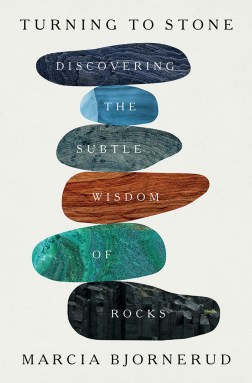
Turning to Stone
Marcia Bjornerud
Flatiron Books, $28.99
Marcia Bjornerud sits in the basement of a soon-to-be-demolished building at Lawrence University in Appleton, Wis. The sole faculty member remaining in a depleted geology department, she sorts through castaway lab equipment, books and rocks. Anything she doesn’t save is destined for the dumpster. One of her student helpers moves a display case, revealing a hidden door leading to a secret storage room crammed with crates of granite.
Bjornerud is exhausted and dizzy. She’s grappling with her department’s collapse, the sleep deprivation of early motherhood and a strained marriage to a terminally ill husband decades her senior. She empathizes with the forgotten granites. They have persisted for over a billion years, though geologists’ interpretations of them have changed. Life is the same, she realizes. “The past is immutable, but its meaning changes with time.”
This story and reflection is one of many in Bjornerud’s latest book, Turning to Stone — part memoir, part geology explainer, part meditation on science and society. Bjornerud, now a tenured structural geologist at the same university (which eventually replenished its geology department), stitches together seemingly disparate topics to tell the tales of rocks that helped her “understand what it means to be an Earthling.”
Bjornerud’s life scaffolds each chapter; the rocks set the scene. The book is largely chronological, from Bjornerud’s childhood to the present day. Each chapter features a titular rock type that holds some significance to her life. Sandstone, for instance, shaped her childhood in ways she didn’t understand until she was a full-fledged geologist.
In the part of Wisconsin in which Bjornerud grew up, the rock had once formed the foundation of the Big Woods of Little House in the Big Woods fame. The forests were logged and cleared for agriculture, leaving behind sandy soil that was never meant to host more than pines. Increasing amounts of fertilizer, needed to produce “a reasonable harvest,” seeped through the porous sandstone into aquifers, contaminating the groundwater that provided most households in her community with drinking water, she writes.
Bjornerud’s eloquent storytelling, complete with tantalizing geologic controversies, entices readers to turn the page — and learn complex science concepts along the way. Take the loads of granite Bjornerud unearthed in the secret room. How did these rocks form? In the early 20th century, some vocal geologists posited that sedimentary rocks morphed into granite through some cryptic chemical process. But experiments beginning in the 1920s conducted by geologist Norman Bowen revealed how Earth’s mantle contained all the necessary ingredients to yield a variety of rocks. He found that, depending on how melted mantle cooled, rocks ranging from basalt to granite could form.
Throughout the narrative, Bjornerud sprinkles tidbits about the people in her orbit. She describes her marriages in varying levels of detail and drops snippets about her children and adopted Ojibwe sister. But readers interested in learning more about these people’s lives may leave wanting more. They are not the central characters. Bjornerud and Earth are.
When Bjornerud came of age during the 1980s, geology was “redefining itself as a more rigorous, quantitative science.” Numerical modeling and lab experiments were gaining favor over “old-school” geology, which relied mostly on field observations. Bjornerud was small, young and a woman — she didn’t fit the mold of what a geologist looked like. She realized that she could not speak of “field experiences as transcendent spiritual epiphanies” if she wanted to be taken seriously.
But now, Bjornerud feels free to reverently describe her connection to the rocks she studied. “I feel lucky to have spent enough time in the company of rocks to understand their language,” she writes. Diamictites from the Norwegian archipelago of Svalbard told her of ancient ice sheets. Pseudotachylyte from New Zealand’s South Island hinted at past earthquakes.
The view that Earth is impassive has paved the path to environmental catastrophe and cultural anomie, Bjornerud writes. “We don’t remember who we really are.” In this book, readers will see the world through her eyes, and perhaps accept her invitation into a geocentric world view, “in which rocks are raconteurs, companions, mentors, oracles, and sources of existential reassurance.”
Buy Turning to Stone from Bookshop.org. Science News is a Bookshop.org affiliate and will earn a commission on purchases made from links in this article.
#Turning #Stone #paints #rocks #storytellers #mentors
Image Source : www.sciencenews.org